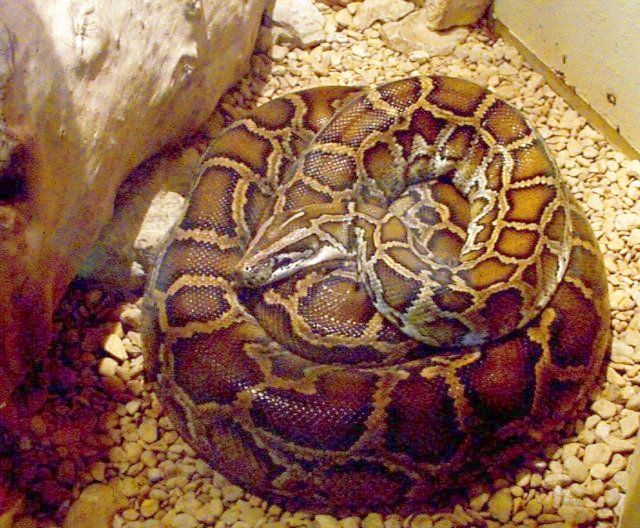| | Burmese python |
| Scientific name: Python molarus bivittatus Range: Old World, especially in India Habitat: Grassland to "open jungle" Status: Threatened Diet in the wild: Rabbits, mice, rats, amphibians, lizards, other snakes, birds, and other mammals Diet in the zoo: Rats, mice, rabbits, domestic pigs, and goats Location in the zoo: Herpetarium |
Physical description: Burmese pythons are one of the six biggest kinds of snakes in the world. They can weigh up to two hundred pounds and can grow up to 240 inches (20 feet long). Burmese python hatchlings are anywhere from 18 to 29 inches. These hatchlings weigh around 4 ounces. The largest pythons are always female. They can grow from 13 to 20 feet while the typically smaller males grow from 8 to 17 feet. However, most Burmese pythons in general grow to a length of around 8 feet. The males and females can be "distinguished by external features. In males the anal spurs on each side of the cloaca are much more developed than in females. Females often have different coloration and a smaller head relative to the body." It is not known how long that a Burmese python will live in the wild for they have not been marked. However, one of these pythons lived "in the San Diego Zoo ... 22 years 9 months. Pythons are constrictors, therefore they don't have fangs and they are non-venomous. They have back-curving teeth which seize the animal and don't allow them to escape. Because the snake's body is long and thin, the organs are long and thin also. Snakes usually only have one thin lung. However, "pythons have two lungs" - one of which is considerably smaller than the other. They lack eyelids but they do have a thin epidermal membrane covering the eyes to protect them. They have "supraorbital bones on the sides of the skull. The pre-maxillary bone generally bears teeth. They have small heat pits, or holes, in their upper lip which allows them to "detect heat radiations" that are in the air from animals that are close by. They also have two rows of tail scales.
 A python's finest sense is in it's olfaction. Pythons are able to smell with the aid of the "Jacobson's organ in the roof of the mouth." They dart their tongues in and out of their mouths to obtain gases from the air. The tongue brings in small particles to this organ. Therefore, the python can catch their prey in light or dark conditions. This allow them to hunt in dense jungles or even at night. Pythons do not have to eat very often, though. One python "fasted 149 days and lost just ten percent of its weight". Pythons are individuals and they each behave differently. However, pythons usually eat about once a week. They bite into an animal with their back-curving teeth. When the animal tries to pull away, they only sink further onto the python's fangs. Next, the python coils around the animal to squeeze the breath out or, in some cases, to constrict its muscles and cause the main blood vessels to explode. Then they swallow the prey whole with the aid of their hinged jaws. When Burmese pythons are out looking for food, they usually first bask in the morning sun so that they will get warm enough to be able to move around and search for food. Because they are cold-blooded, they must get heat from outside the body. The best way for them to get warm is to lie in the sun and that's why pythons naturally occur in tropical climates where the temperature is warm. After they eat, they will spend the mornings after out in the sun keeping warm in order to digest their food.
A python's finest sense is in it's olfaction. Pythons are able to smell with the aid of the "Jacobson's organ in the roof of the mouth." They dart their tongues in and out of their mouths to obtain gases from the air. The tongue brings in small particles to this organ. Therefore, the python can catch their prey in light or dark conditions. This allow them to hunt in dense jungles or even at night. Pythons do not have to eat very often, though. One python "fasted 149 days and lost just ten percent of its weight". Pythons are individuals and they each behave differently. However, pythons usually eat about once a week. They bite into an animal with their back-curving teeth. When the animal tries to pull away, they only sink further onto the python's fangs. Next, the python coils around the animal to squeeze the breath out or, in some cases, to constrict its muscles and cause the main blood vessels to explode. Then they swallow the prey whole with the aid of their hinged jaws. When Burmese pythons are out looking for food, they usually first bask in the morning sun so that they will get warm enough to be able to move around and search for food. Because they are cold-blooded, they must get heat from outside the body. The best way for them to get warm is to lie in the sun and that's why pythons naturally occur in tropical climates where the temperature is warm. After they eat, they will spend the mornings after out in the sun keeping warm in order to digest their food.